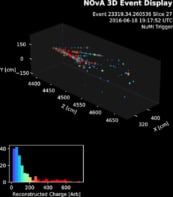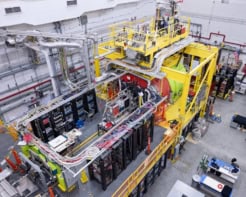
Physicists at CERN’s Large Hadron Collider (LHC) are analysing the results of their first attempt at colliding protons and lead ions. Further attempts at proton–lead collisions are expected over the next few weeks. If these trials are successful, a full-blown experimental programme could run in 2012.
Since the Geneva lab began experiments with the LHC in 2009, it has mostly been used to send two beams of protons in opposite directions around the 27 km accelerator, with the hope of spotting, among other things, the Higgs boson in the resulting collisions. Two beams of lead ions have also been smashed into each other in order to recreate the hot dense matter, known as a quark–gluon plasma, that was present in the early universe.
But to fully understand the results of such collisions, physicists need to know the properties of the lead ions before they collide. That is, their “cold state” before vast amounts of heat are released by the collisions. One way to do this, according to Urs Wiedemann at CERN, is to collide protons with lead ions.
Parton distribution
The problem at the moment is that our knowledge of the “parton distribution functions” for high-energy lead ions is not good enough to fully understand the results of lead–lead collisions at the LHC. Partons are the quarks and gluons that make up hadrons such as protons and neutrons – and hence the lead nuclei. At low energies hadrons can be thought of as containing just three valence quarks that interact via gluons. However, at the energies found in the LHC, hadrons comprise a large number of additional partons that can significantly affect how collisions occur. This “sea” of partons is described by a distribution function, which cannot be calculated to the desired degree of accuracy – so physicists must rely on experimental measurements.
The advantage of lead–proton collisions is that when a proton smashes into a lead nucleus, it does not heat the nucleus up much. The collision can therefore be analysed to reveal important details about the parton distribution functions of the lead ions in their cold state.
First test ‘successful’
The first test occurred on Monday and lasted 16 hours. CERN accelerator physicist John Jowett described it as “extremely successful”. Jowett and colleagues first injected a few lead bunches in the presence of 304 proton bunches. A few bunches of each were then accelerated to the LHC’s current full energy of 3.5 TeV for protons and 287 TeV for lead – or 1.38 TeV per lead nucleon.
At this top energy both beams are extremely relativistic. This means that with a small adjustment of the orbits, the protons and lead ions take the same time to complete one circuit of the accelerator. Initially, the lead and proton bunches met some 9 km away from the ATLAS experiment, but the team was able to move this meeting point back to the centre of ATLAS. This procedure lines up the bunches so they collide properly in all four experiments.
Jowett stresses that the beams were separated transversely so there have been no collisions yet. He added, “We still need to do some analysis of our data to determine whether the lead beam sizes were being blown up more than they usually are by other effects – that’s important for projecting future performance.”
Further sessions on proton–lead collisions are planned at the LHC over the next four weeks, although most of the beam time in November will be devoted to lead–lead collisions.
N.B. This article was updated on 3 November 2011.



